The medical latex protective suit market is projected to grow from USD 3.0 billion in 2025 to USD 5.0 billion by 2035, at a CAGR of approximately 5.1%. A key opportunity in the medical latex protective suit market lies in the expansion of surgical and clinical procedure volumes, particularly in developing healthcare systems where hospital capacity, surgical center networks, and emergency care facilities are expanding. Latex-based suit systems offer high tactile flexibility, ergonomic movement, and reliable antimicrobial barrier performance, making them preferred for operating rooms, isolation wards, infectious disease units, and trauma care environments. As patient throughput increases, hospitals are investing in single-use and controlled-use protective gear to reduce contamination risk and maintain procedural hygiene. This creates sustained procurement cycles for disposable protective suits, supported by national healthcare budgets and institutional infection control protocols.
Another major opportunity arises from the integration of advanced material engineering and manufacturing automation to enhance comfort, durability, and regulatory compliance. Growing emphasis on hypoallergenic latex formulations, improved ventilation zones, and ergonomic seam designs is driving product differentiation. Manufacturers offering sterility-certified, fluid-resistant, and heat-sealed construction solutions are well-positioned to serve both general medical and specialized high-risk facilities. Additionally, the emergency response, pandemic preparedness, and disaster relief sectors represent expanding demand channels, as governments and health agencies build protective equipment reserves. Long-term supplier agreements, localized production hubs, and supply chain resilience strategies will further strengthen market growth potential.

The latter half (2030-2035) will witness sustained growth from USD 3.9 billion to USD 5 billion, representing an addition of USD 1.1 billion or 57% of the decade's expansion. This period will be defined by mass market penetration of specialized protective designs, integration with comprehensive hospital safety platforms, and seamless compatibility with existing healthcare infrastructure. The market trajectory signals fundamental shifts in how medical facilities approach infection control optimization and healthcare worker safety management, with participants positioned to benefit from sustained demand across multiple usability types and end-use application segments.
The Medical Latex Protective Suit market demonstrates distinct growth phases with varying market characteristics and competitive dynamics. Between 2025 and 2030, the market progresses through its technology adoption phase, expanding from USD 3 billion to USD 3.9 billion with steady annual increments averaging 5.3% growth. This period showcases the transition from basic protective garments to advanced disposable medical latex systems with enhanced barrier capabilities and integrated safety control systems becoming mainstream features.
The 2025-2030 phase adds USD 0.9 billion to market value, representing 43% of total decade expansion. Market maturation factors include standardization of infection control and healthcare safety protocols, declining production costs for specialized latex formulations, and increasing industry awareness of barrier protection benefits reaching 98-99% contamination prevention effectiveness in surgical and isolation applications. Competitive landscape evolution during this period features established protective equipment manufacturers like Ansell and Honeywell expanding their medical latex portfolios while specialty manufacturers focus on advanced barrier development and enhanced comfort capabilities.
From 2030 to 2035, market dynamics shift toward advanced material integration and global healthcare expansion, with growth continuing from USD 3.9 billion to USD 5 billion, adding USD 1.1 billion or 57% of total expansion. This phase transition centers on specialized latex protection systems, integration with automated sterilization networks, and deployment across diverse surgical and emergency scenarios, becoming standard rather than specialized applications. The competitive environment matures with focus shifting from basic protection capability to comprehensive safety optimization systems and integration with hospital infection control platforms.
| Metric | Value |
|---|---|
| Market Value (2025) | USD 3 billion |
| Market Forecast (2035) | USD 5 billion |
| Growth Rate | 5.3% CAGR |
| Leading Technology | Disposable Medical Latex Protective Suit Type |
| Primary Application | Surgical Protection Application Segment |
The market demonstrates strong fundamentals with disposable medical latex protective suit systems capturing a dominant share through advanced barrier design and infection prevention capabilities. Surgical protection applications drive primary demand, supported by increasing procedure volumes and stringent safety technology requirements. Geographic expansion remains concentrated in developed markets with established healthcare infrastructure, while emerging economies show accelerating adoption rates driven by hospital expansion and rising infection control standards.
Market expansion rests on three fundamental shifts driving adoption across the surgical, isolation, and emergency response sectors. First, infection control demand creates compelling operational advantages through medical latex protective suits that provide immediate barrier protection and contamination prevention without compromising healthcare worker mobility, enabling facilities to meet stringent safety standards while maintaining surgical productivity and reducing cross-contamination risks. Second, healthcare safety modernization accelerates as hospitals worldwide seek advanced protective systems that complement traditional infection control processes, enabling precise barrier customization and safety monitoring that align with industry standards and regulatory requirements.
Third, pandemic preparedness enhancement drives adoption from healthcare facilities and emergency services requiring effective protective solutions that maximize worker safety while maintaining operational productivity during infectious disease outbreaks and hazardous exposure operations. However, growth faces headwinds from latex allergy cost challenges that vary across healthcare providers regarding the accommodation of sensitive personnel and alternative material requirements, which may limit adoption in allergy-prone environments. Technical limitations also persist regarding heat stress concerns and mobility restrictions that may reduce effectiveness in extended-duration procedures and physically demanding scenarios, which affect worker comfort and operational requirements.
The medical latex protective suit market represents a specialized yet critical safety opportunity driven by expanding global surgical volumes, infection control modernization, and the need for superior healthcare worker protection in diverse medical applications. As facilities worldwide seek to achieve 98-99% barrier effectiveness, reduce infection transmission, and integrate advanced protective systems with safety platforms, medical latex protective suits are evolving from basic protective garments to sophisticated barrier solutions ensuring worker safety and infection control leadership.
The market's growth trajectory from USD 3 billion in 2025 to USD 5 billion by 2035 at a 5.3% CAGR reflects fundamental shifts in healthcare industry safety requirements and infection control optimization. Geographic expansion opportunities are particularly pronounced in Asia Pacific markets, while the dominance of disposable systems and surgical protection applications provides clear strategic focus areas.
Strengthening the dominant disposable medical latex protective suit segment through enhanced barrier formulations, superior contamination prevention, and cost-effective production systems. This pathway focuses on optimizing latex composition, improving wearing comfort, extending operational effectiveness to 98-99% barrier rates, and developing specialized formulations for diverse applications. Market leadership consolidation through advanced material engineering and automated production integration enables competitive positioning while defending advantages against alternative materials. Expected revenue pool: USD 95-125 million
Rapid surgical and hospital infrastructure growth across Asia Pacific creates substantial expansion opportunities through local production capabilities and technology transfer partnerships. Growing procedure volumes and government infection control initiatives drive sustained demand for advanced protective systems. Localization strategies reduce import costs, enable faster supply support, and position companies advantageously for hospital procurement programs while accessing growing domestic markets. Expected revenue pool: USD 80-110 million
Expansion within the dominant surgical protection segment (45.0% market share) through specialized latex designs addressing operating room standards and high-volume procedure requirements. This pathway encompasses sterile packaging systems, quality control integration, and compatibility with diverse surgical facility processes. Premium positioning reflects superior barrier protection and comprehensive contamination prevention supporting modern surgical operations. Expected revenue pool: USD 70-95 million
Strategic expansion into isolation and nursing care applications (30.0% market share) requires enhanced comfort capabilities and specialized latex formulations addressing extended-wear operational requirements. This pathway addresses patient care safety, infection barrier enhancement, and long-duration protection with advanced material engineering for demanding healthcare standards. Premium pricing reflects specialized comfort requirements and extended durability standards. Expected revenue pool: USD 60-80 million
Development of specialized latex protective suit formulations for laboratory protection (15.0% share) and emergency response (8.0%), addressing specific hazardous material requirements and infectious disease containment demands. This pathway encompasses chemical resistance, biohazard protection, and rapid-deployment alternatives for specialized medical scenarios. Technology differentiation through proprietary formulations enables diversified revenue streams while reducing dependency on single application platforms. Expected revenue pool: USD 50-70 million
Expansion of reusable medical latex protective suit segment through enhanced durability, sustainable laundering protocols, and specialized applications requiring extended-use protective characteristics. This pathway encompasses industrial sterilization compatibility, cost-per-use optimization, and environmental alternatives for facilities with established reprocessing infrastructure. Market development through sustainable design engineering enables differentiated positioning while accessing cost-conscious markets requiring durable protection solutions. Expected revenue pool: USD 40-55 million
Development of superior barrier protective suit formulations addressing regulatory compliance and safety requirements across surgical and isolation applications. This pathway encompasses FDA certification integration, infection control validation, and comprehensive safety documentation. Premium positioning reflects safety leadership and regulatory expertise while enabling access to highly regulated procurement programs and compliance-focused hospital partnerships. Expected revenue pool: USD 35-50 million
Primary Classification: The market segments by usability type into Disposable Medical Latex Protective Suit and Reusable Medical Latex Protective Suit categories, representing the evolution from single-use protective garments to sustainable barrier solutions for comprehensive infection control optimization.
Secondary Classification: Application segmentation divides the market into Surgical Protection, Isolation and Nursing Care, Laboratory Protection, Emergency Response, and Others sectors, reflecting distinct requirements for barrier intensity, wearing duration, and contamination prevention standards.
Regional Classification: Geographic distribution covers Asia Pacific, Europe, North America, and other regions, with developed markets leading adoption while emerging economies show accelerating growth patterns driven by healthcare expansion programs.
The segmentation structure reveals technology progression from standard latex garments toward specialized barrier systems with enhanced safety and comfort capabilities, while application diversity spans from surgical facility protection to specialized emergency response and laboratory applications requiring precise contamination prevention solutions.
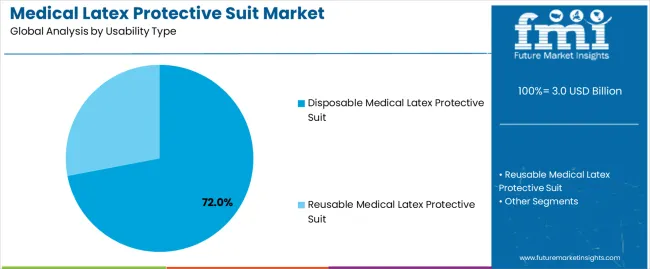
Market Position: Disposable medical latex protective suit systems command the leading position in the Medical Latex Protective Suit market with approximately 72.0% market share through advanced barrier properties, including superior contamination prevention, convenient single-use capability, and infection control optimization that enable facilities to achieve optimal worker protection across diverse surgical and isolation environments.
Value Drivers: The segment benefits from healthcare facility preference for reliable protective systems that provide consistent barrier performance, reduced cross-contamination risk, and safety assurance without requiring sterilization infrastructure. Advanced material features enable rapid donning procedures, waste disposal simplicity, and integration with existing infection control protocols, where barrier reliability and contamination prevention represent critical safety requirements.
Competitive Advantages: Disposable medical latex protective suit systems differentiate through proven infection prevention, consistent protection quality, and integration with hospital safety systems that enhance operational effectiveness while maintaining optimal barrier integrity suitable for diverse medical applications.
Key market characteristics:
Reusable medical latex protective suit systems maintain sustainable protection positioning in the Medical Latex Protective Suit market due to their durable construction properties and environmental advantages. These systems appeal to facilities requiring cost-effective protective materials with adequate performance for routine isolation and laboratory applications. Market adoption is driven by sustainability program expansion, emphasizing reliable barrier solutions and operational efficiency through optimized reprocessing systems while maintaining competitive cost-per-use structures.
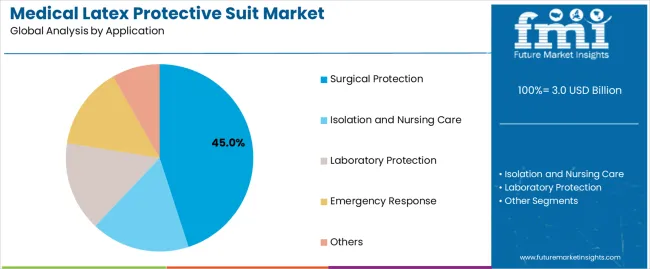
Market Context: Surgical protection applications dominate the Medical Latex Protective Suit market with approximately 45.0% market share due to widespread adoption of infection control and increasing focus on sterile field maintenance, contamination prevention, and surgical team safety applications that minimize infection transmission while maintaining healthcare standards.
Appeal Factors: Surgical facilities prioritize barrier reliability, sterility assurance, and integration with existing operating room infrastructure that enables coordinated protective equipment across multiple procedure types. The segment benefits from substantial healthcare facility investment and infection control programs that emphasize the acquisition of protective suits for surgical team safety and contamination prevention applications.
Growth Drivers: Surgical volume expansion programs incorporate medical latex protective suits as standard equipment for operating room operations, while minimally invasive procedure growth increases demand for barrier protection capabilities that comply with sterile technique standards and minimize surgical site infections.
Market Challenges: Varying surgical procedure standards and operating room protocol differences may limit protective equipment standardization across different healthcare facilities or procedural scenarios.
Application dynamics include:
Isolation and nursing care applications capture approximately 30.0% market share through specialized protection requirements in infectious disease management, patient isolation protocols, and extended healthcare contact applications. These facilities demand comfortable protective systems capable of maintaining barrier integrity while providing extended-wear capability and patient care functionality.
Laboratory protection applications account for approximately 15.0% market share, emergency response captures 8.0%, while other segments represent 2.0%, including veterinary medicine protection, pharmaceutical manufacturing, and specialized healthcare applications requiring latex protective capabilities for contamination control and safety compliance.
Growth Accelerators: Surgical procedure expansion drives primary adoption as medical latex protective suits provide superior infection prevention capabilities that enable healthcare facilities to meet stringent safety standards without excessive equipment costs, supporting surgical operations and infection control missions that require precise barrier protection applications. Healthcare safety infrastructure demand accelerates market expansion as hospitals seek effective protective systems that minimize cross-contamination while maintaining operational effectiveness during surgical procedures and patient care scenarios. Healthcare spending increases worldwide, creating sustained demand for barrier protection systems that complement traditional infection control processes and provide worker safety in demanding medical environments.
Growth Inhibitors: Latex allergy cost challenges vary across healthcare facilities regarding the accommodation of sensitized personnel and requirements for alternative protective materials, which may limit operational flexibility and market penetration in regions with high allergy prevalence or allergy-sensitive healthcare operations. Technical performance limitations persist regarding heat stress concerns and mobility restrictions that may reduce effectiveness in extended-duration procedures, physically demanding scenarios, or tropical climate conditions, affecting worker comfort and operational requirements. Market fragmentation across multiple healthcare standards and infection control protocols creates compatibility concerns between different protective suit suppliers and existing facility infrastructure.
Market Evolution Patterns: Adoption accelerates in surgical and infectious disease sectors where infection control justifies protective equipment costs, with geographic concentration in developed markets transitioning toward mainstream adoption in emerging economies driven by healthcare expansion and safety awareness. Technology development focuses on enhanced barrier formulations, improved breathability integration, and compatibility with sterilization systems that optimize contamination prevention and worker comfort effectiveness. The market could face disruption if synthetic polymer technologies or powder-free innovations significantly limit the deployment of latex-based protective suits in medical applications, though latex material's unique combination of barrier effectiveness, flexibility, and tactile sensitivity continues to make it preferred in surgical applications.
The Medical Latex Protective Suit market demonstrates varied regional dynamics with Growth Leaders including China (7.2% CAGR) and India (6.6% CAGR) driving expansion through hospital capacity additions and infection control modernization programs. Steady Performers encompass Germany (6.1% CAGR), Brazil (5.6% CAGR), USA (5.0% CAGR), UK (4.5% CAGR), and Japan (4.0% CAGR), benefiting from established healthcare industries and advanced safety equipment adoption.

| Country | CAGR (2025-2035) |
|---|---|
| China | 7.2% |
| India | 6.6% |
| Germany | 6.1% |
| Brazil | 5.6% |
| USA | 5.0% |
| UK | 4.5% |
| Japan | 4.0% |
Regional synthesis reveals Asia Pacific markets leading adoption through healthcare infrastructure expansion and surgical facility development, while European countries maintain steady expansion supported by infection control advancement and safety standardization requirements. North American markets show moderate growth driven by surgical procedure applications and pandemic preparedness integration trends.
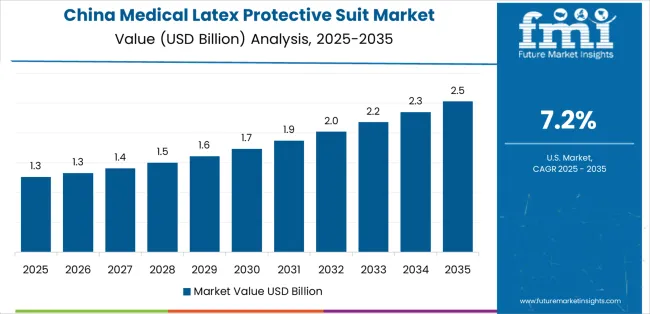
The Chinese market emphasizes advanced protective features, including precision barrier control and integration with comprehensive hospital safety platforms that manage infection quality, sterilization optimization, and contamination prevention applications through unified monitoring systems. The country demonstrates strong growth at 7.2% CAGR, driven by hospital construction expansion, surgical capacity initiatives, and emerging infectious disease preparedness development that support protective equipment integration. Chinese healthcare facilities prioritize operational effectiveness with medical latex protective suits delivering consistent worker safety through advanced barrier capabilities and infection control adaptation features.
Technology deployment channels include major hospital systems, specialized protective equipment suppliers, and healthcare procurement programs that support professional applications for complex surgical protection and isolation care applications. Manufacturing platform integration capabilities with established sterilization systems expand market appeal across diverse operational requirements seeking infection prevention and safety benefits. The expanding healthcare infrastructure and accelerating surgical procedure market create sustained demand, while innovative applications in pandemic response and biosafety protocols open new growth avenues.
Performance Metrics:
Germany's advanced hospital market demonstrates sophisticated protective equipment deployment with documented operational effectiveness in surgical protection applications and isolation facilities through integration with existing infection control systems and safety infrastructure. The country leverages engineering expertise in medical device manufacturing and quality systems integration to maintain strong growth at 6.1% CAGR. Industrial centers, including Frankfurt, Munich, and Hamburg, showcase premium installations where protective suit systems integrate with comprehensive hospital platforms and safety management systems to optimize surgical operations and infection control effectiveness.
German protective equipment manufacturers prioritize system quality and EU compliance in product development, creating demand for premium medical latex systems with advanced features, including validated barrier testing and automated quality systems. The market benefits from established healthcare infrastructure and a willingness to invest in safety technologies that provide long-term infection prevention benefits and compliance with international medical device and quality standards.
Market Intelligence Brief:
The USA medical latex protective suit market demonstrates sophisticated deployment across surgical applications with documented effectiveness in operating room protection and isolation care facilities through integration with comprehensive infection control management systems and safety infrastructure. The country leverages advanced manufacturing capabilities in protective equipment innovation and barrier technologies to maintain moderate growth at 5.0% CAGR. Industrial centers, including Chicago, Boston, and Los Angeles, showcase premium installations where protective suit systems integrate with comprehensive hospital platforms and surgical safety networks to optimize contamination prevention and equipment effectiveness.
American healthcare facilities prioritize infection prevention and worker safety in protective equipment development, creating demand for innovative medical latex systems with advanced features, including antimicrobial integration and comfort-enhanced designs. The market benefits from established surgical infrastructure and willingness to invest in safety technologies that provide long-term infection control benefits and compliance with FDA and CDC standards.
Market Intelligence Brief:
The UK medical latex protective suit market demonstrates advanced safety deployment with documented operational effectiveness in surgical protection applications and isolation facilities through integration with existing infection control systems and healthcare infrastructure. The country leverages regulatory expertise in medical device approval and quality systems integration to maintain steady growth at 4.5% CAGR. Industrial centers, including London, Manchester, and Birmingham, showcase premium installations where protective suit systems integrate with comprehensive safety platforms and infection control systems to optimize regulatory compliance and equipment effectiveness.
British healthcare facilities prioritize infection control and regulatory compliance in protective equipment development, creating demand for certified medical latex systems with advanced features, including validated barrier performance and traceability integration. The market benefits from established hospital infrastructure and commitment to invest in safety technologies that provide long-term infection prevention benefits and compliance with UK and EU medical device standards. Surgical protection applications, isolation care systems, and emergency response programs drive diversified demand across multiple end-use segments.
Strategic Market Indicators:
India's medical latex protective suit market demonstrates rapid expansion deployment with documented operational effectiveness in hospital surgical applications and isolation facilities through integration with emerging healthcare systems and facility development infrastructure. The country leverages growing manufacturing capabilities in medical equipment production and quality systems integration to achieve high growth at 6.6% CAGR. Industrial centers, including Mumbai, Delhi, and Bangalore, showcase expanding installations where protective suit systems integrate with comprehensive hospital platforms and safety networks to optimize market penetration and infection control effectiveness.
Indian healthcare facilities prioritize cost efficiency and safety standards in protective equipment development, creating demand for sophisticated medical latex systems with advanced features, including automated production integration and quality control systems. The market benefits from expanding hospital infrastructure and willingness to invest in international-standard safety technologies that provide infection prevention and compliance with evolving healthcare standards.
Market Intelligence Brief:
Brazil's medical latex protective suit market demonstrates growth deployment with documented operational effectiveness in surgical facility applications and hospital isolation units through integration with expanding healthcare systems and medical infrastructure. The country leverages economic capabilities in healthcare growth and facility systems integration to maintain steady growth at 5.6% CAGR. Industrial centers, including Sao Paulo, Rio de Janeiro, and Belo Horizonte, showcase expanding installations where protective suit systems integrate with comprehensive hospital platforms and safety networks to optimize infection control and equipment effectiveness.
Brazilian healthcare facilities prioritize infection prevention and cost efficiency in protective equipment development, creating demand for cost-effective medical latex systems with advanced features, including tropical climate adaptation and barrier protection systems. The market benefits from growing hospital infrastructure and commitment to invest in safety technologies that provide infection control and compliance with Brazilian healthcare standards.
Strategic Market Indicators:
Japan's medical latex protective suit market demonstrates precision deployment with documented operational effectiveness in premium surgical applications and specialty hospital facilities through integration with advanced healthcare systems and quality control infrastructure. The country leverages engineering excellence in medical device manufacturing and quality systems integration to maintain steady growth at 4.0% CAGR. Industrial centers, including Tokyo, Osaka, and Yokohama, showcase premium installations where protective suit systems integrate with comprehensive quality platforms and infection control systems to optimize safety excellence and equipment effectiveness.
Japanese healthcare facilities prioritize manufacturing precision and safety quality in protective equipment development, creating demand for ultra-premium medical latex systems with advanced features, including micro-precision manufacturing and quality integration systems. The market benefits from established hospital infrastructure and commitment to invest in highest-quality safety technologies that provide superior infection prevention and compliance with stringent Japanese healthcare standards.
Strategic Market Indicators:
<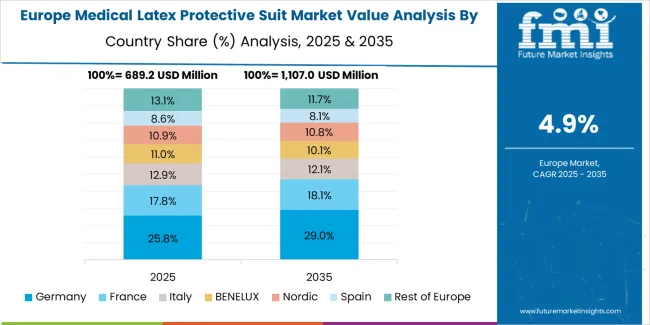
The Medical Latex Protective Suit market in Europe is projected to grow from USD 820 million in 2025 to USD 1.3 billion by 2035, registering a CAGR of 4.8% over the forecast period. Germany is expected to maintain its leadership position with a 31.2% market share in 2025, declining slightly to 30.5% by 2035, supported by its advanced hospital infrastructure and major surgical centers in Frankfurt and Munich. The UK follows with a 22.4% share in 2025, projected to reach 22.8% by 2035, driven by comprehensive infection control programs and surgical safety initiatives.
France holds a 17.6% share in 2025, expected to increase to 18.1% by 2035 through steady healthcare modernization activities. Italy commands a 12.8% share, while Spain accounts for 8.5% in 2025. The Rest of Europe region is anticipated to show steady adoption, expanding its collective share from 7.5% to 8.3% by 2035, reflecting consistent growth in Nordic countries, hospital expansion in Central European markets, and infection control upgrades across Eastern European healthcare facilities.

In Japan, the Medical Latex Protective Suit market prioritizes disposable medical latex protective suit systems, which capture the dominant share of surgical and hospital installations due to their advanced features, including precision barrier optimization and seamless integration with existing infection control infrastructure.
Japanese healthcare facilities emphasize reliability, precision, and long-term safety excellence, creating demand for disposable medical latex protective suit systems that provide consistent protection capabilities and superior barrier performance based on infection control requirements and quality standards. Reusable medical latex protective suits maintain secondary positions primarily in routine laboratory applications and non-critical care installations where comprehensive protective functionality meets operational requirements without compromising safety efficiency.
Market Characteristics:
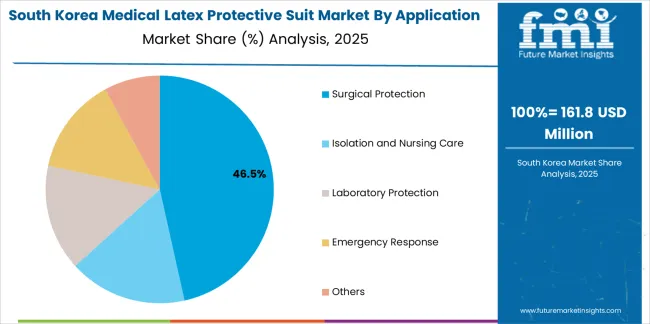
In South Korea, the market structure favors international protective equipment manufacturers, including Ansell, Honeywell, and DuPont, which maintain dominant positions through comprehensive product portfolios and established healthcare industry networks supporting both surgical protection and isolation care installations.
These providers offer integrated solutions combining advanced medical latex protective suit systems with professional technical services and ongoing quality support that appeal to Korean hospitals seeking reliable infection control equipment. Local protective equipment contractors and safety consultants capture moderate market share by providing localized service capabilities and competitive pricing for standard healthcare protection installations, while domestic manufacturers focus on specialized applications and cost-effective solutions tailored to Korean healthcare market characteristics.
Channel Insights:
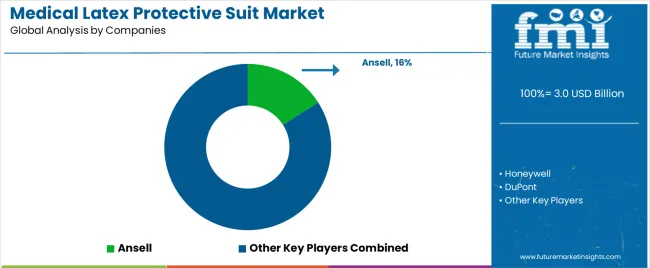
The Medical Latex Protective Suit market operates with moderate concentration, featuring approximately 16-20 meaningful participants, where leading companies control roughly 40-46% of the global market share through established healthcare industry relationships and comprehensive protective equipment portfolios. Competition emphasizes advanced barrier capabilities, material quality, and regulatory compliance rather than price-based rivalry. The leading company, Ansell, commands approximately 16.0% market share through its extensive medical protective equipment product line and global healthcare industry presence.
Market Leaders encompass Ansell, Honeywell, and DuPont, which maintain competitive advantages through extensive medical device expertise, global hospital networks, and comprehensive barrier technology capabilities that create customer loyalty and support premium pricing. These companies leverage decades of protective equipment experience and ongoing innovation investments to develop advanced medical latex systems with precision infection control and safety features. Technology Innovators include 3M and regional specialists, which compete through specialized barrier formulation technology focus and innovative comfort capabilities that appeal to healthcare facilities seeking advanced protection solutions and worker safety enhancement.
These companies differentiate through rapid product development cycles and specialized surgical application focus. Regional Specialists feature protective equipment manufacturers focusing on specific geographic markets and specialized applications, including regulatory compliance systems and integrated hospital safety solutions. Market dynamics favor participants that combine reliable barrier formulations with advanced safety capabilities, including precision quality control and automatic contamination prevention features. Competitive pressure intensifies as traditional medical device suppliers expand into protective suit systems, while specialized infection control companies challenge established players through innovative barrier solutions and sustainable platforms targeting surgical protection and isolation care segments.
| Item | Value |
|---|---|
| Quantitative Units | USD 3 billion |
| Usability Type | Disposable Medical Latex Protective Suit, Reusable Medical Latex Protective Suit |
| Application | Surgical Protection, Isolation and Nursing Care, Laboratory Protection, Emergency Response, Others |
| Regions Covered | Asia Pacific, Europe, North America, Latin America, Middle East & Africa |
| Countries Covered | China, India, Germany, Brazil, USA, UK, Japan, and 20+ additional countries |
| Key Companies Profiled | Ansell, Honeywell, DuPont, 3M, Cardinal Health, Medline Industries, Top Glove Corporation, Hartalega Holdings Berhad, Supermax Corporation, Mölnlycke Health Care, Paul Hartmann AG, B. Braun Melsungen AG, Semperit AG Holding, MAPA Professionnel, Unigloves |
| Additional Attributes | Dollar sales by usability type and application categories, regional adoption trends across Asia Pacific, Europe, and North America, competitive landscape with protective equipment manufacturers and healthcare suppliers, facility preferences for infection control and worker safety, integration with hospital sterilization platforms and quality monitoring systems, innovations in barrier formulation technologies and comfort excellence, and development of automated manufacturing solutions with enhanced performance and safety optimization capabilities. |
The global medical latex protective suit market is estimated to be valued at USD 3.0 billion in 2025.
The market size for the medical latex protective suit market is projected to reach USD 5.0 billion by 2035.
The medical latex protective suit market is expected to grow at a 5.3% CAGR between 2025 and 2035.
The key product types in medical latex protective suit market are disposable medical latex protective suit and reusable medical latex protective suit.
In terms of application, surgical protection segment to command 45.0% share in the medical latex protective suit market in 2025.






Full Research Suite comprises of:
Market outlook & trends analysis
Interviews & case studies
Strategic recommendations
Vendor profiles & capabilities analysis
5-year forecasts
8 regions and 60+ country-level data splits
Market segment data splits
12 months of continuous data updates
DELIVERED AS:
PDF EXCEL ONLINE
Medical Activated Carbon Dressing Market Size and Share Forecast Outlook 2025 to 2035
Medical Coated Roll Stock Market Size and Share Forecast Outlook 2025 to 2035
Medical Billing Outsourcing Market Size and Share Forecast Outlook 2025 to 2035
Medical Pressure Mapping System Market Size and Share Forecast Outlook 2025 to 2035
Medical Chairs Market Size and Share Forecast Outlook 2025 to 2035
Medical Exoskeleton Market Forecast Outlook 2025 to 2035
Medical Display Market Forecast and Outlook 2025 to 2035
Medical Spa Market Size and Share Forecast Outlook 2025 to 2035
Medical Face Shield Market Forecast and Outlook 2025 to 2035
Medical Robot Market Size and Share Forecast Outlook 2025 to 2035
Medical Nutrition Market Forecast and Outlook 2025 to 2035
Medical Wax Market Size and Share Forecast Outlook 2025 to 2035
Medical Specialty Bag Market Size and Share Forecast Outlook 2025 to 2035
Medical Plastics Market Size and Share Forecast Outlook 2025 to 2035
Medical Device Tester Market Size and Share Forecast Outlook 2025 to 2035
Medical Device Trays Market Size and Share Forecast Outlook 2025 to 2035
Medical Adhesives Market Size and Share Forecast Outlook 2025 to 2035
Medically Supervised Weight Loss Services Market Size and Share Forecast Outlook 2025 to 2035
Medical Smart Drug Cabinet Market Size and Share Forecast Outlook 2025 to 2035
Medical EMR Input Device Market Size and Share Forecast Outlook 2025 to 2035

Thank you!
You will receive an email from our Business Development Manager. Please be sure to check your SPAM/JUNK folder too.
Chat With
MaRIA